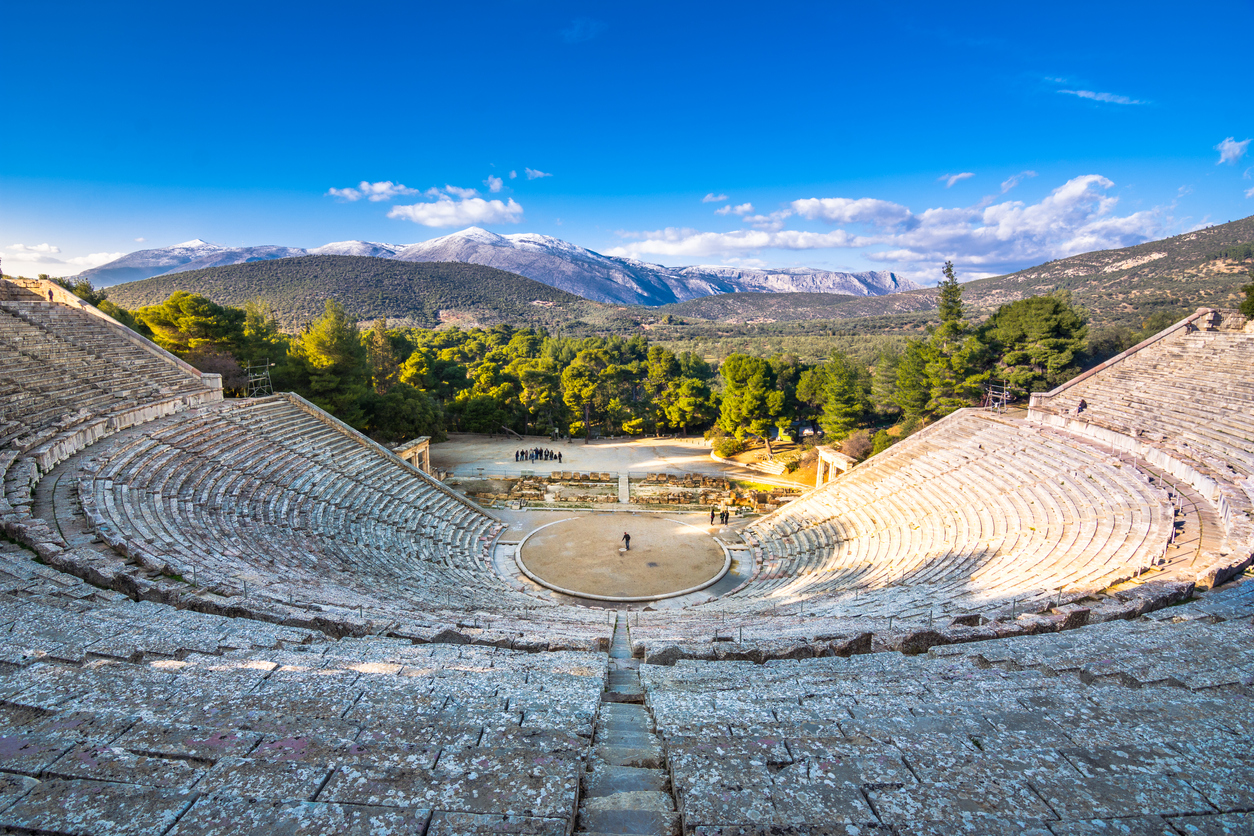Top Peloponnese Wineries in Greece, Wine Tasting & Tour Options: Travel Guide for 2025
Although the Peloponnese wine region is not yet a household word, it is a land full of placenames you are sure to know. Olympia, Sparta, Corinth and Kalamata are a few destinations within Peloponnese that have so much history to reveal.
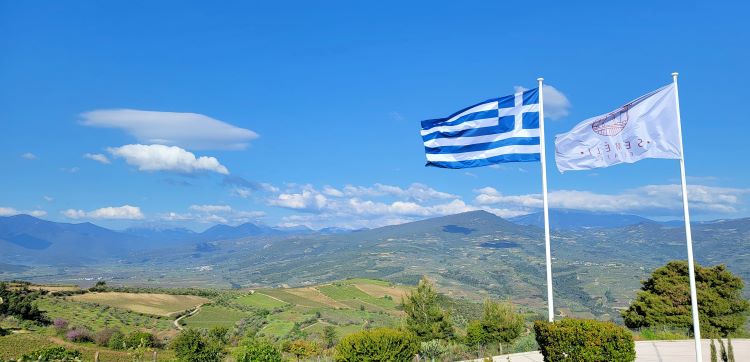
Archaeological artifacts, including representations of grape clusters on Greek coins, amphoras (ceramic wine shipping containers) and sommeliers depicted on ancient vases, prove that this region’s winemaking legacy stretches back to antiquity. In recent years, Peloponnese winemakers and growers are now breathing life into indigenous grapes once cultivated by ancient Greeks.
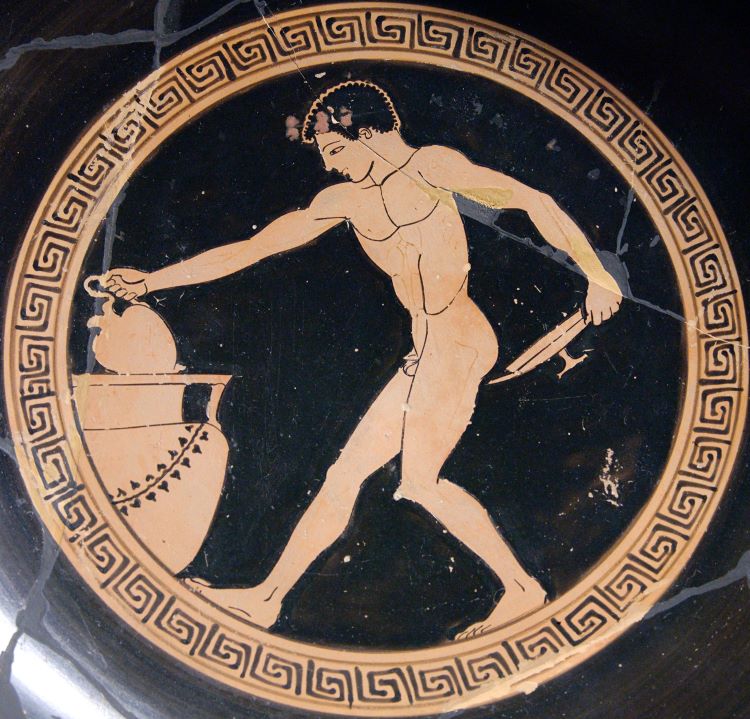
One of the most fascinating aspects that entice #Winetravelers to Peloponnese is the remarkable fact that 91% of the grape varieties cultivated here are indigenous to the region. Peloponnese vineyards proudly nurture and showcase an exquisite array of indigenous Greek varieties, including:
- Agiorgitiko (red and rosé)
- Mavrodaphne (red)
- Monemvassia (found in sweet and dry PDO white wines and in PDO red wines)
- Moschofilero (white, rosé and fine sparkling)
- Muscat (white, including two PDO wines)
- Roditis (white)
The vast Peloponnese region produces 31% of Greek wines. And when you look at the awards and accolades from around the world, you’ll find that many of the Peloponnese are considered the best Greek wines. Further, 60% of wines produced in the Peloponnese region are white.
- Top Peloponnese Wineries in Greece, Wine Tasting & Tour Options: Travel Guide for 2025
- Where is Peloponnese in Greece?
- Getting to the Peloponnese Wine Region
- Getting Around the Peloponnese Wine Region
- Four Regions You Must Visit for Peloponnese PDO Wines
- Map of Best Greece Wineries To Visit in Peloponnese
- Boutique Wineries and Wine Tours by Geographical Area
- If You Visit Greece Wineries in Peloponnese
- Frequently Asked Questions about Greek Wineries in Peloponnese
Where is Peloponnese in Greece?
When you examine a map of Greece, the shape of Peloponnese is reminiscent of a grape leaf. An over 8000 square mile / +21,000 square kilometer grape leaf! The area includes a mountainous interior and beachy coastline sandwiching rich agricultural lands dotted with olive groves and vineyards.
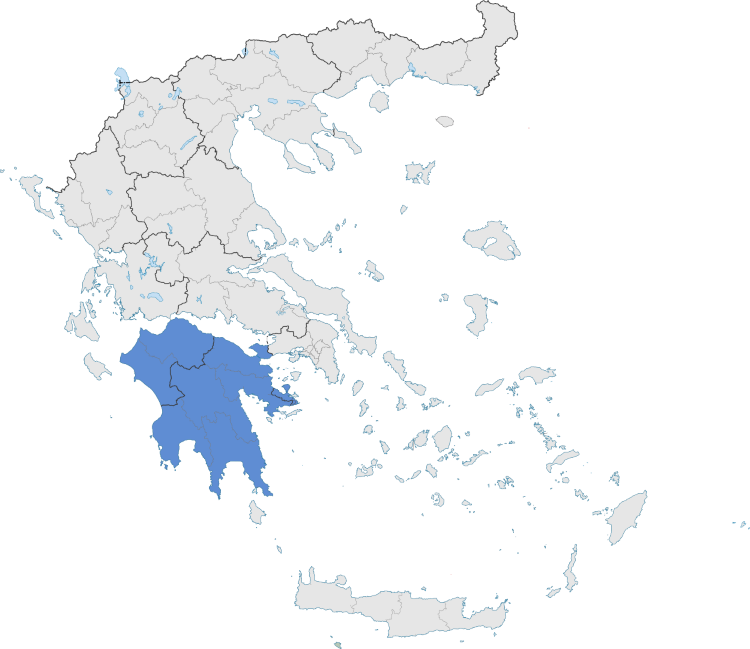
The peninsula is divided into four subregions connected by picturesque, winding roads perfect for road-tripping wine travelers. But because the Peloponnese is so large and offers so many UNESCO sites, beaches and Greece wineries, planning a trip can be, well, simply overwhelming. So that is why we’ve developed this guide to the best Greece wineries to visit in Peloponnese. This field guide will help you discover the people and places that would be difficult to find on your own.
Getting to the Peloponnese Wine Region
Two international airports serve the Peloponnese: Athens (ATH) and Kalamata (KLX). You can check current flight deals into Greece here on Kayak.
Getting Around the Peloponnese Wine Region
The best way to get around the Peloponnese wine region is to rent a car. Check here for some of the best rental car rates in Greece. On country roads, open the windows of your vehicle to smell the fresh scents of forest and fields.
Or sit back and relax on a private, guided wine tour that includes transportation to and from Athens airport.
Four Regions You Must Visit for Peloponnese PDO Wines
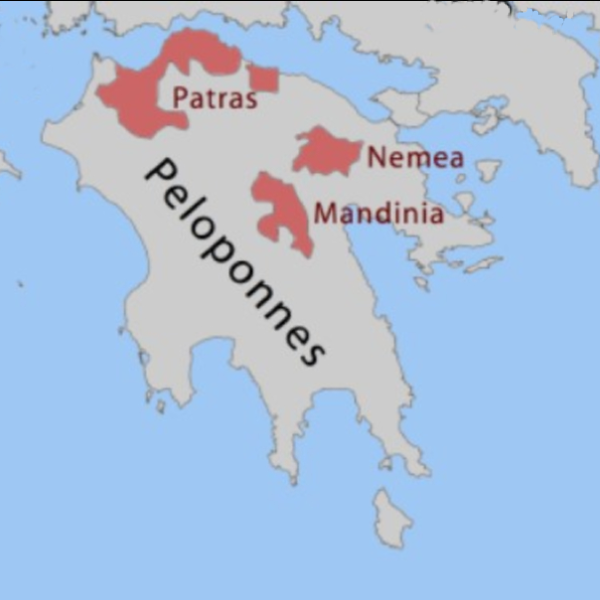
With over 180 Peloponnese Greece wineries producing hundreds of labels, knowing where to start planning a wine trip can be overwhelming. After hitting the road with Peloponnese wine experts, Winetraveler created this guide to ensure you don’t miss the incredible history, culture and nature.
To make it easy for you, the guide focuses on four subregions based on the production areas of Peloponnesian PDO wines (Protected Designation of Origin). The PDOs comply with national and European legislation and are closely linked to authentic Greek terroirs that you won’t want to miss experiencing.
- PDO Nemea
- PDO Mantinia
- PDO Monemvasia – Malvasia
- PDOs of Patras – There are four PDOs in the Patras region
Overall, the Peloponnese climate is Mediterranean, with short winters and hot summers. The central and eastern regions are very hot and dry, while the west is milder, with more precipitation and humidity.
Map of Best Greece Wineries To Visit in Peloponnese
Make sure to call ahead or book online for reservations at Greece wineries.
Boutique Wineries and Wine Tours by Geographical Area
Explore the following Peloponnese Greece wineries listed by geographical area for your convenience. Be sure to call ahead or book online before you arrive. Private drivers and customizable day trips are available on Viator. Luxury private wine tours are also available, and we recommend this particular full-day tour that takes you around in a Mercedes, stopping at Nafplio and along the Corinth Canal.
PDO Nemea
The Nemea region, the top producer of Greek red wines, is only one and a half hours from the Athens airport. When exploring the charming town of Nemea, you’ll find helpful signage to guide you to the 40-45 wineries in the area. Be sure to keep an eye out for the signs and enjoy the highly acclaimed PDO Nemea wines that await you!
Semeli Estate

Yiannis Flerianos, the talented winemaker of Semeli Estate, approaches his craft with a sense of care and dedication. With a twinkle in his eye, he describes his wines to Winetraveler.com: “They are my children. You have the grumpy ones, the nice ones. You have them all.”
Throughout the conversation, Yiannis’ intimate connection with the wines he produces from native grapes like the Agiortiko and the Moschofilero is evident. With years of experience and a true passion for winemaking, Yiannis finesses each grape varietal with meticulous attention, bringing out a diverse range of flavors and characters in his wines. From the elegant and refined to the bold and expressive, Yiannis’ creations reflect his skill and artistry.
Later when pouring the Semeli Nemea Grand Reserve, he confesses, “This is the spoiled child. The Grand Reserve requires at least four years of aging, with two years spent in oak. It is only produced during perfect years and is considered a prized product.”
“Every type of wine has its unique character and story to tell, which is significant to us. These qualities stem from the conversations held between the winemaker and the wine. We have a lot of conversations,” Yiannis laughs.
As a winemaker, he understands that each wine possesses its own unique personality, much like his “children.” It is this genuine love and commitment that make Yiannis Flerianos a notable figure in the world of winemaking, and his wines from Semeli Estate a true testament to his expertise.
Don’t miss Semeli Estate on top of the hill—it’s a feast for the eyes and taste buds with an upscale, modern design that indulges all the senses. The winemakers leverage their hilltop position for a gravity flow production system that reduces the use of pumps and electricity. At the sustainability-focused VIP destination that is a favorite for corporate retreats, you can taste wines in the historical cellar or winemaker’s dinners or lunches. “It’s special treatment, so you need reservations,” says Yiannis.
Before your visit, contact the winery at +306970963633 or hospitality@semeliestate.gr.
Palivos Estate
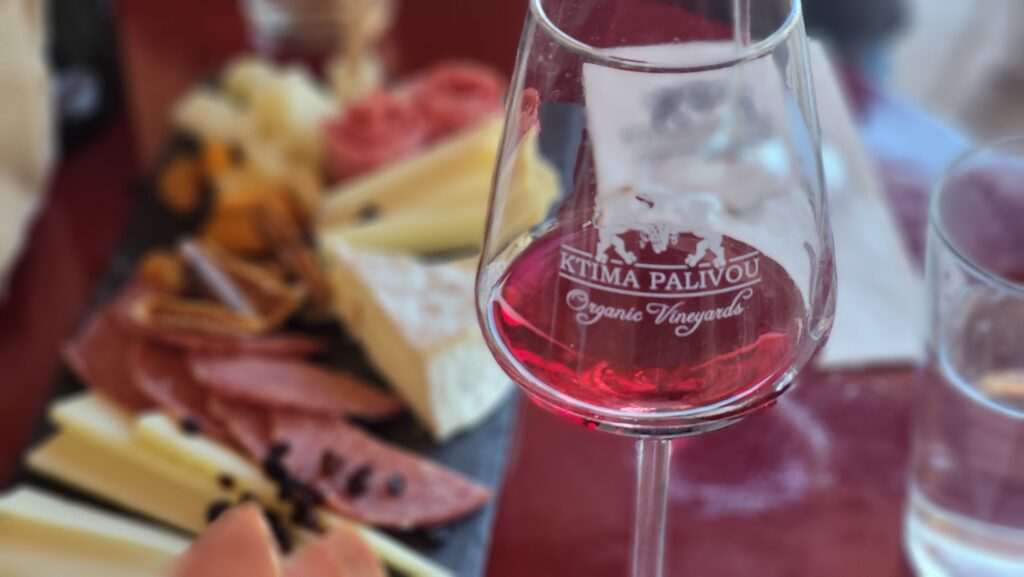
Palivos Estate organic winery in Nemea is a labor of love, evident in the attention to detail and passion of its owner, Geórgios Palivos and winery host, Elena. She proudly shares, “All our grapes are handpicked,” highlighting the meticulous care given to every vine. She further explains that in the past, workers foot-pressed the grapes.
Walking among the terraced rows of vines, Elena playfully addresses the pronunciation challenge of Agiorgitiko, the prominent grape variety grown in Nemea. She suggests a clever phonetic device, pointing to herself and saying “I,” then pointing at her guest and saying “Your.” Then she adds “Yitigo,” resulting in “I – Your – Yitigo.” Agiorgitiko roughly translates to St. George wine.
At Palivos Estate, winemaker Geórgios Palivos and his team employ another traditional method: aging and maturing their wines in clay pots. Elena leads guests into the wine barn, where they get a glimpse of this intriguing process.
She explains the benefits and reveals that the clay pots allow the wine to interact with oxygen, enabling it to breathe and develop additional secondary aromas. Later in the process, the wine is blended and left to mature in oak barrels. This combination of clay pot aging and oak barrel maturation showcases Palivos Estate’s commitment to crafting wines with complexity and depth.
Don’t pass on charcuterie platters of local hams, salamis, cheeses, figs and Corinthian raisins. (You’ll discover the history and importance of the Corinthian raisins later in this guide.) It’s an eye-appealing accompaniment to your wine tastings.
Lafazanis Winery
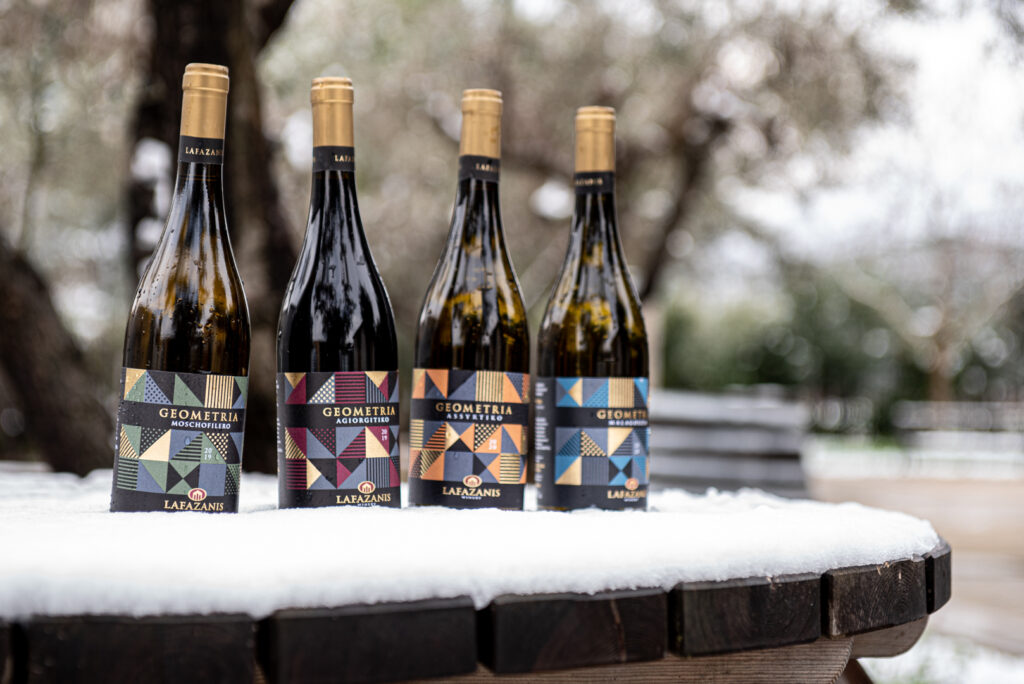
“Our wines are the authentic expression of the varieties. Each is different,” Spyros Lafazanis told Winetraveler. The winemaker and owner of Lafazanis Winery is committed to crafting high-quality products that fulfill all taste and price requirements. So he challenges his team of bright and hardworking oenologists by setting the bar even higher.
You’ll taste how they coax out the expression of the Agiorgitiko, Roditis and other native varieties in each glass you taste at the state-of-the-art winery and hip tasting room.
Gaia Wines
In the village of Koutsi of Nemea, Gaia Wines provides a short walk through the vineyard of Gaia Estate, a tour of the winery and cellar and wine tastings of the whole range of Gaia Wines.
Beyond Wine in Nemea
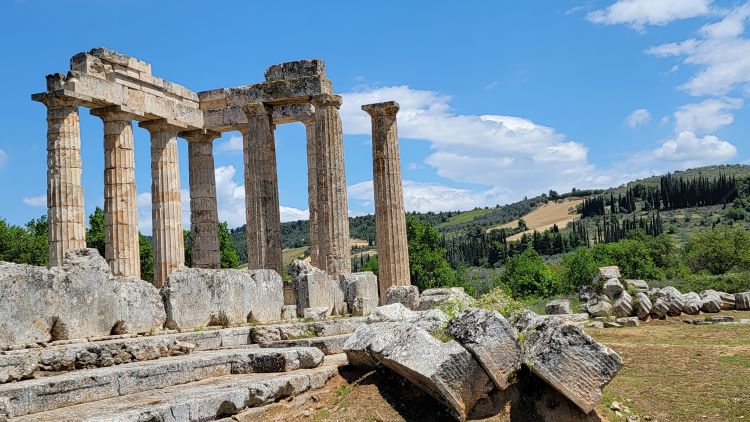
Besides wine, Nemea romances visitors with a delightful blend of history, natural beauty and spirituality. History buffs can explore the ancient Nemean Ruins and immerse themselves in the well-preserved Temple of Zeus. Nearby lies what is left of the medieval Monastery of Our Lady of the Rocks. The ruins are part of a settlement mentioned in 1377 as “Santo Georgio de Polifengno.” Texts dating back to Turkish rule referred to it as Saint George, the name of Nemea at the time. The name of the lauded Agiorgitiko variety of Nemea wines is derived from this affiliation with Saint George.
Nature enthusiasts can revel in the picturesque Nemea Valley (blink, and you’d swear you were in Tuscany) while embarking on scenic hikes, perhaps to the monastery. With its mix of history, natural wonders, divine serenity and exquisite wines, Nemea offers a genuinely captivating and enriching journey for all.
Where to Stay
Stay in Nafplion by the water and Arvanitia Beach, about a 38-minute drive from Nemea.
Where to Eat
Order lunch or dinner in advance at Semeli Estates, or get your fill with a charcuterie board at Palivos Estate.
Patras – Roditis Grape, Mavrodaphne
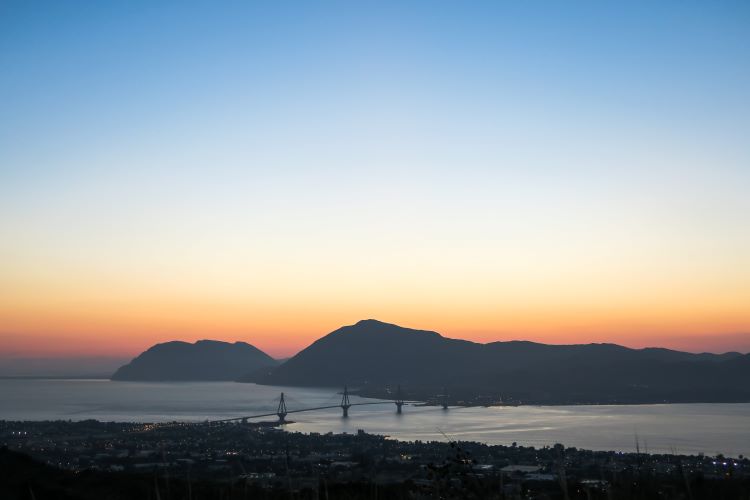
You’ll discover four styles of PDO wine across Patras, each made from different varieties and awarded their own appellations.
- PDO Patras was awarded the appellation for Roditis, an aromatic white grape said to produce one of the finest white wines in Greece.
- PDO Mavrodaphne is a sweet wine of naturally sun-dried grapes.
- PDO Muscat of Patras covers all muscat produced in this method in and around Patras.
- The PDO Muscat of Rio Patras encompasses a much smaller area encroached by the city.
Book an all-day wine tour of the mountains from Patras.
Tetramyhos Winery
Tetramyhos Winery, located on remote mountain slopes and steeped in history, exemplifies the indomitable spirit of winemaking. According to Panayiotis Papagiannopoulos, the illustrious winemaker, “Even during the Ottoman occupation, they produced wine in this area …because of the taxes.” The Turks, known to destroy vineyards, could collect revenues from wines consumed by pilgrims and other wayfarers that traveled further up the mountain to Mega Spileon Monastery.
“Wine was the energy drink of the ancient times,” adds the oenologist about the resilience of the region’s winemakers, who persevered through challenging times. Today, Tetramyhos Winery continues to honor tradition while crafting exceptional wines that reflect the essence of the land and its people.
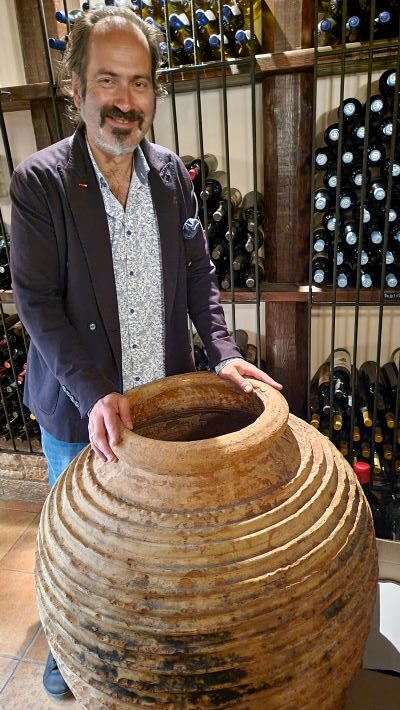
Panayiotis, the passionate winemaker of the biowinery, has seamlessly blended science and traditional methods to craft exceptional organic wines. The vineyards, situated uphill from the warm and inviting winery, have been cultivated organically since 1997.
The expert employs various time-honored techniques to capture the essence of the terroir in his wines. He harmoniously merges innovation with tradition by using ceramic pots lined with local beeswax to prevent leakage and concrete egg fermenters that evoke ancient Greek amphoras or oak barrels.
Another nod to tradition is found in his retsina wine, where he incorporates pine resin from the property’s pine trees. When visiting the tasting room, keep an eye out for the aromatic hints of pine in the Retsina Amphore, crafted from the Roditis grape, and savor the delightful notes of licorice and violet flowers in the Agiorgitiko Natur.
Then buy a few bottles and bring them to the nearby Stevanto Hotel Restaurant on the beach for lunch. The owner will open the bottles for you and recommend the grilled eggplant to accompany the seafood caught that day.
Mega Spileon Monastery / Ktima Mega Spileo
Ktima Mega Spileo is a historical vineyard on the premises of a monastery built into a cave in 362 AD. The ancient Byzantine church can be visited when the weather permits.
Native varieties grown at this mountain hideaway include Mavrodaphne, which has become symbolic of Greek wines over the centuries. The vineyard now belongs to Greece’s most prominent wine company, CAVINO.
Achaia Clauss (one of the very first wineries in Greece)
This winery traces its roots back to 1861 when Gustav Clauss, a Bavarian entrepreneur, ventured to Patras in 1854 to join a German raisin export company. During one of his journeys, he encountered the captivating landscapes of the region. Inspired by what he saw, Clauss purchased a modest 15-acre vineyard and constructed the timeless Winecastle, which stands as a testament to his vision to this day.
You can discover the secrets of the wine castle with its Imperial Cellar and barrels full of Mavrodafni at Achaia Clauss, now the oldest winery in Greece.
Beyond Wine Near the Patras PDOs
Mountains and beaches are close by. Explore the diverse geological, natural and cultural elements of Helmos-Vouraikos Geopark, which earned it Geoparks of UNESCO designation. Or enjoy relaxing at one of the many pebbled beaches around Patras that offer views of the majestic Rio–Antirrio Bridge, the world’s longest multi-span cable-stayed bridge.
Where to Stay
Stay at Stavento Hotel near Tetramyhos Winery. You’ll find plenty of things to in Patras or the ski town of Kalavryta on Tripadvisor.
Where to Eat
Eat grilled specialties on the pebble beach at the Stavento Hotel Restaurant, or find restaurants in Patras town or Kalavryta.
Mantinia PDO
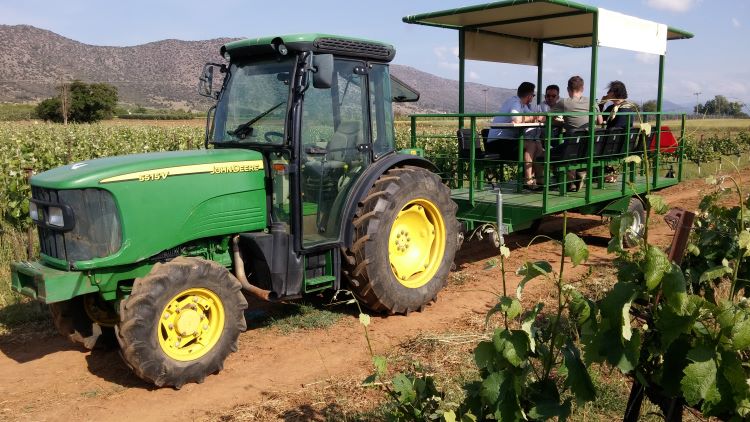
The elevated Mantineia plateau is renowned as the ancestral home of the gray-skinned Moschofilero grape, making it a pivotal component of Mantinia PDO wines. Indeed, Moschofilero must comprise a minimum of 85 percent of the Mantinia PDO blend.
Flourishing in one of Greece’s coldest wine-growing regions, this late-ripening grape thrives in low temperatures, allowing its unique aromas and flavors to fully develop. With similarities to the Traminer grape, Moschofilero stands out with its elevated acidity, rendering it an excellent choice for crafting sparkling wines.
Troupis Winery
For a unique experience, tour the lush vineyards in a special trailer pulled by a John Deere tractor. You’ll taste wine in the fields at Troupis Winery, which creates delicious wines made of Agiorgitiko, Moschofilero, Mavrodaphne and other indigenous varieties. The elevated guest experience includes a well-furnished tasting room and visits to the cellar and modern laboratory.
Ktima Tselepos
One of the oldest Greece wineries in Mantinia, Ktima Tselepos receives its guests with Greek hospitality. French-trained vintner and owner Yiannis Tselepos was the first of modern winemakers to resurrect Moschofilero by producing top-quality monovarietal wines from the native grape. Lunch is available by advance request.
Kalogris Organic Winery
Located only 20 miles from the coast, Kalogris Organic Winery produces terroir-driven wines with 100% estate-owned grapes. The wines were planted between 1980 when the family founded the winery in their grandfather’s stone-built home, and 1995. The green winery focuses on the Moschofilero grape.
Beyond Wine in the Mantinia PDO
Enjoy the morning at the UNESCO Archaeological Site of Mystras near Sparta. Book a tour of the Sparta Acropolis on TripAdvisor. In the heat of the day, visit Kapsia Cave, one of the most notable caves in Greece, which is listed as a World Heritage Experience.
Where to Stay
Stay at any of these hotels in Tripoli or Mystras.
Where to Eat
Lunch is available at Ktima Tselepos if arranged in advance. Stop at Glykopolio in Tripoli for its highly-rated brunch and desserts. Or the elegant Villa Incognito, also in Tripoli. Both offer vegetarian choices.
PDO Monemvasia-Malvasia
On the shores of the Aegean Sea, Monemvasia offers not only captivating medieval charm but also a delightful destination for wine enthusiasts. Known for its ancient fortress town and nearby vineyards, Monemvasia provides a unique opportunity for wine tasting amidst a picturesque backdrop.
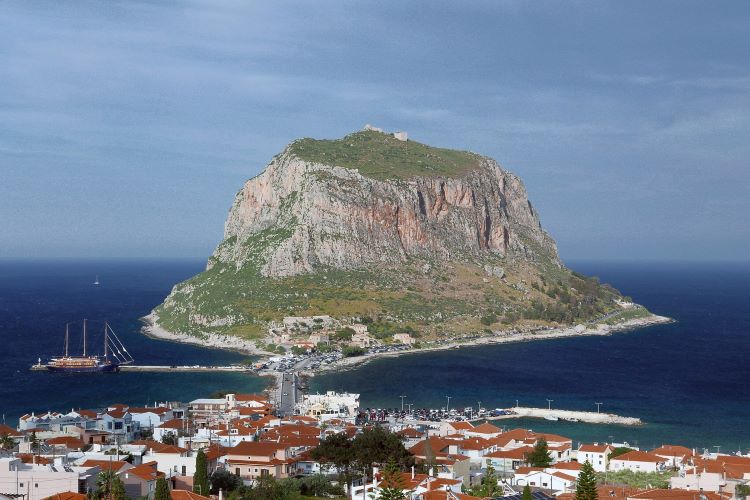
The region boasts a rich viticultural heritage, cultivating indigenous grape varieties such as Malvasia and Agiorgitiko. Visitors can savor the flavors of these distinctive wines while exploring the narrow cobblestone streets of the medieval town or enjoying panoramic views from the hillside vineyards where the latest PDO, Monemvassia-Malvasia, was established on July 23, 2021.
Book tours on TripAdvisor or contact Effie Anagnopoulou, a licensed tour guide and Monemvasia archaeologist.
Monemvasia Winery Tsimbidis
Dedicated to the revival of Malvasia wine, renowned worldwide in the late Middle Ages, Monemvasia Winery Tsimbidi searched for native varieties and experimented with traditional vinification methods.
Although legendary since the 12th century and called by the placename of its origin, byzantine Monemvasia, the wine ceased to exist when during the Turkish occupation in the 16th century, the vineyards of Malvasia were destroyed. The wine process was forgotten.
Now, after years of research, plantings and experimental vinification, the winery’s organic vineyards grow a collection of rare varieties that characteristically express the terroir of Monemvasia.
Beyond Wine in PDO Monemvassia-Malvasia
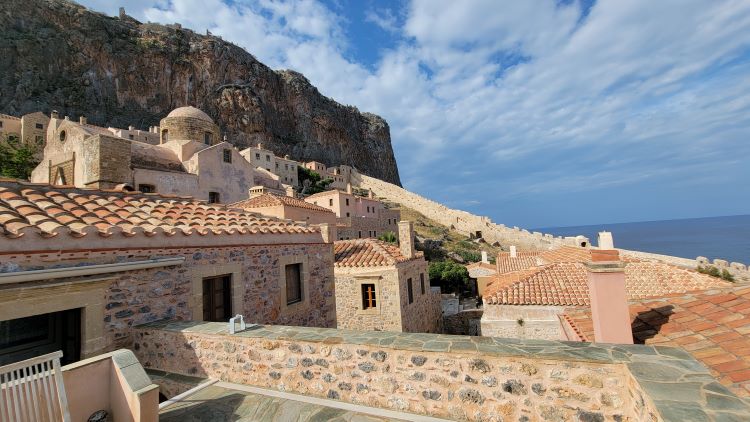
Hikers will enjoy climbing through the medieval town’s tunnels and twisting stone stairways to the top where the Monastery of Monemvasia delivers sea views. Nature lovers can’t miss an afternoon of exploring the mind-blowing Kastania Cave, classified as the second of its kind in Europe, and Agios Nikolaos Geopark at the peninsula’s southern tip.
Or reserve a half-day tour of Elafonisos Island from Monevasia on Viator.
Where to Stay
Stay inside the walled medieval town at Theophano Art Hotel, a tastefully decorated historic stone building with marble floors and rooftop terraces.
Where to Eat
The outstanding food and service at Diamantis Fish Restaurant in Gerakas Port are well worth the 35-minute scenic drive along the coast or lunch. During a rooftop dinner inside the medieval city, peruse the wine list at Kanoni Restaurant and Wine Bar that names wines from Greece wineries, including Monemvasia Winery Tsimbidis, of course.
Western Peloponnese Wineries Ilia Region
Although the Illia region in western Peloponnese does not have a PDO designation, the following two Greece wineries should be included on your Peloponnese wine tour.
Mercouri Estate
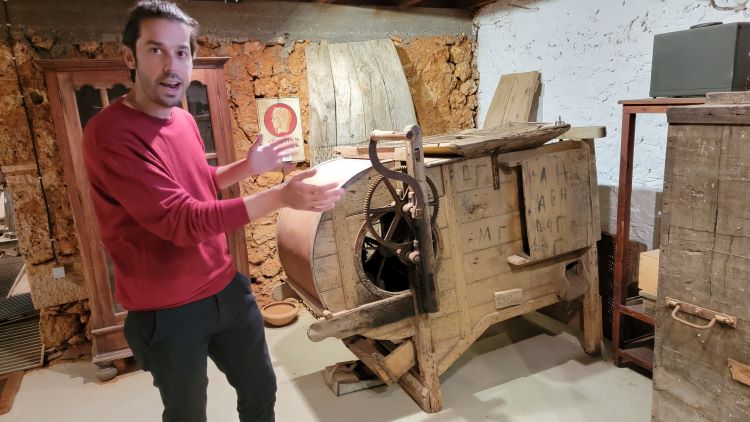
You will indeed be charmed by the deep history told by the collection of farming artifacts, historic buildings and family members of Mercouri Estate. The family has been working this land since 1864, making Mercouri Estates the second longest-running of Greece wineries.
During your visit, you’ll learn that from the 1870s to the early 1900s, the Corinthian raisin held immense significance for Mercouri Estates and the Peloponnese region. The Corinthian raisin, made from the small Sultana grape, was highly sought after domestically and internationally. Its production and exportation provided a vital source of income for Mercouri Estates, which employed dozens of local people. The success of the Corinthian raisin trade bolstered the region’s economy, promoted regional development and contributed to the overall cultural identity of Peloponnese during that era.
But when the raisin market declined, the family turned to wine production. Just when you think you’ve seen all there is to see during any wine tour around the world, you’ll be escorted into underground concrete tanks that stored 300 tons of wine in the 1930s or another corner of this fascinating place.
“Our focus is on circular economy and sustainability,” says youthful Labis Kanellakopoulous, the fifth generation of the family. “Making wine is not an easy way to make money, but it’s the lifestyle.”
Winetravelers sailing into Katakolo Port can reserve a shore excursion with a private tasting at Mercouri Estate on Viator.
Ktima Brintziki
Near ancient Olympia, the birthplace of the Olympic Games, is Ktima Brintziki, Europe’s first energy-independent green winery. Besides producing wine that contains no sulfates or preservatives, the winery boasts a zero-energy footprint. Stay at the guesthouse, tour a traditional water mill and taste organic wines, some rare or scarce indigenous varieties. Ask about performances in their open-air theatre.
Beyond Wine in Western Peloponnese
Traveling between Katakolo Port and Olympia offers a captivating mix of history, nature, and cultural experiences. Around Katakolo Port and Pyrgos, experience traditional architecture and warm hospitality, indulging in authentic Greek cuisine. Enjoy a refreshing swim at Paralia Spiantza beach or outdoor adventures in Olympia’s surrounding hills. Explore Olympia’s ancient ruins, then venture through picturesque villages surrounded by olive groves and vineyards.
Where to Stay
Stay in the highly-rated guesthouse at Ktima Brintziki Winery or find another charming place between Katakolo Port and Olympia on Tripadvisor.
H5: Where to Eat
Marina Fish Taverna overlooking the sea just north of Katakolo docks, is the local families’ choice for fresh Greek fish and seafood, other made-to-order delicacies and top-notch service.
If You Visit Greece Wineries in Peloponnese
If you plan to visit Greece wineries in Peloponnese, please drop a note in the comments below. And check out these valuable resources:
The Wine Producers’ Association of the Peloponnese Vineyard (ENOAP)
Peloponnese Wineries mobile app on Google Play
*Travelers to Greece wineries should be aware of another legal classification used: Peloponnesian PGI wines (Protected Geographical Indication). As many know, the protected geographical indication is the name of an area or a specific place used to describe an agricultural product or a foodstuff.
However, to keep this guide straightforward, we are concentrating on the regions of Peloponnese PDO wines.
According to the Wine Producers’ Association of the Peloponnese Vineyards, Peloponnesian PGI wines are not in the same quality category as PDO wines. Their website says, “Still, to a great extent, they demonstrate originality and authenticity in their varieties and production areas.” Learn more about Peloponnese PGI wines.
Pin This Article to Pinterest for Later
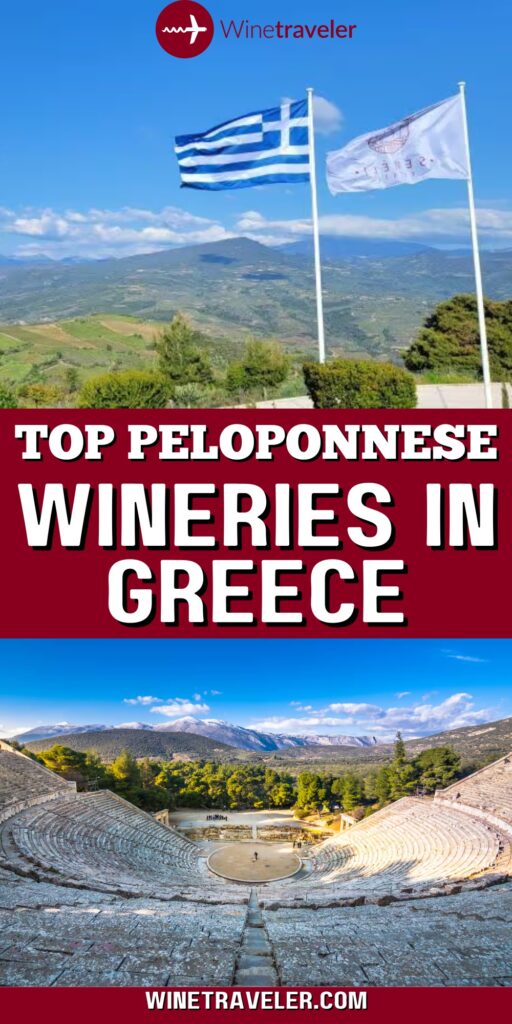
Frequently Asked Questions about Greek Wineries in Peloponnese
You are reading “Best Greece Wineries in Peloponnese: Wine Tastings, Tours & Travel Guide” Back To Top
wineries near me, wine experiences in Greece, Peloponnese travel guide, travel to Peloponnese : best wine country road trips
If you enjoyed this guide, make sure you register to become a Winetraveler for free! You’ll get access to all of our content and interact with other Winetravelers and for travel inspiration around the world. Be sure to follow along with us on Twitter and Instagram as we continue to feature more exciting destinations.
